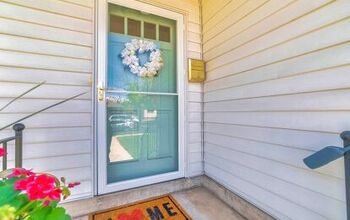How To Measure For A Replacement Swing Canopy (Quickly & Easily!)

Having a canopy porch swing can be a game-changer when it comes to social gatherings like dinners, barbeques, and cocktail hours. They also add additional comfort to your personal leisure time. Canopy porch swings are cozy, casual, and a great way to relax and comfortably enjoy the fresh outdoor air while covered by the shade of the canopy.
To measure for a replacement swing canopy, you will need to do the following:
- Remove your old canopy and lay it on the ground
- Ensure the canopy is flat.
- Using a tape measure, check the length and width of the canopy.
- Factor in the seam allowance as well for the final measurement.
There are a number of things to consider when shopping around for the right replacement swing canopy. The most important of these being the dimensions.
Do You Need Handyman Services?
Get free, zero-commitment quotes from pro contractors near you.

How to Measure for Replacement Swing Canopy
Determining the exact measurements of your swing canopy is the most important consideration when looking for a replacement. If you still have the old fabric attached to your swing, this should not be particularly difficult. Follow the steps outlined below to properly measure for your replacement swing canopy:
- Remove the old canopy from your swing’s frame.
- Lay the canopy out on the ground in an area that is large enough for it to rest flat. Use special care not to rip any of the canopy’s edges, as this could result in inaccurate measurements. Depending on the cleanliness of the canopy, you may want to calculate these measurements outdoors or in a garage.
- Use a tape measure to determine the accurate length and width of the canopy fabric. Make sure to factor in seam allowance where it was once attached over the frame arms.
In some instances, you may not have the convenience of the old canopy to help you determine the proper measurements. If this is the case, you have two options. For the first, you can measure from the outer edge of each of the frame’s supporting brackets. This will give you a general idea of what the correct dimensions are. Or, you can research similarly designed porch swings to draw a conclusion on sizing.
While this seems like a relatively simple and straightforward method, porch swing canopies can come in a variety of shapes. The procedure for determining the canopies dimensions will vary slightly based on the shape it is. Swing canopies usually come in three shapes: curved, flat, and gazebo style.
How to Measure for Curved Swing Canopy
Curved swing canopies are the most common and widely used type. They are exactly as the name indicates: curved, almost like a cylinder cut in half. To determine the dimensions of a curved swing canopy, you need to gather two separate measurements:
- Length of Main Section: To measure the length, you’ll want to run your tape measure along the fabric on the long side of the canopy. Measure the edge from corner to corner (or seam, if there is a fringe or valance).
- Width of Main Section: To measure the width, you’ll be running your tape measure along the fabric on the short side of the canopy. Measure the edge from corner to corner (or seam, if there is a fringe or valance).
These measurements will yield the dimensions needed to find a replacement for your curved swing canopy.
How to Measure for Flat Swing Canopy
Another type of swing canopy is the flat variety. Flat swing canopies are, as they sound, flat with a fringe or valance that extends off of all or most of the edges. To determine the dimensions of a flat swing canopy, you need to gather three distinct measurements:
- Length of Main Section: To measure the length of the main section, you’ll want to extend your tape measure along the edge of the fabric (or seam, if there is a fringe or valance) from corner to corner along the canopy’s longest side.
- Width of Main Section: To measure the width of the main section, you’ll want to extend your tape measure along the edge of the fabric (or seam, if there is a fringe or valance) from corner to corner along the canopy’s shortest side.
- Depth of Fringe or Valance: The fringe or valance is a section of decorative drapery that is attached to the canopy. To determine the depth of this decorative element, you’ll simply measure the height of it.
These measurements will yield the dimensions needed to find an exact replacement for your flat swing canopy.
How to Measure for Gazebo Swing Canopy
The final type of swing canopy is a gazebo style canopy. This design is generally a pentagonal shape, whose five sides meet at the top at long apex. To determine the dimensions of a gazebo style swing canopy, you need to gather four specific measurements:
- Length of Main Section: To measure the length of the main section, run your tape measure along the longest side of the canopy, from corner to corner. Measure along the edge of the fabric (or seam, if there is a fringe or valance).
- Width of Main Section: To measure the width of the main section, run your tape measure along the shortest side of the canopy, from corner to corner. Measure along the edge of the fabric (or seam, if there is a fringe or valance).
- Corner to Peak: To determine this measurement, you’ll want to run your tape measure from one corner to the peak along the seam.
- Length of the Apex: The apex is the top portion of the canopy. To measure its length, simply measure along the edge of the fabric at the top of the apex.
These measurements will yield the dimensions needed to find an exact replacement for your gazebo style swing canopy.
Other Replacement Swing Canopy Considerations
The style and dimensions of your swing canopy are just a few of the factors you should consider when it’s time for a replacement. Some other things you’ll want to keep in mind when choosing the right canopy include:
- Fabric/Material: Material is a major component of any type of replacement swing canopy. We recommend opting for the most heavy-duty fabric possible. Also, choosing one that is water-resistant will be very durable and repel water and liquid spills. Although, the waterproof treatment may need to be reapplied periodically to keep the fabric in working condition.
- Installation: The physical install of your canopy is another thing you’ll want to consider. If you purchase a new canopy with the correct dimensions and it doesn’t fit upon installation, you may be out of luck. Pay close attention to where the sleeves and clips attach to the swing’s frame, along with any specific installation features. It may help to draft a diagram detailing how the canopy is supposed to connect to the frame. That way, you can compare your diagram to the manufacturer’s specs and make sure you select the right canopy.
- Maintenance: If you want a canopy that doesn’t require much work, choose one that is easy to maintain. Although most canopies will require occasional cleanings, some may necessitate significantly more maintenance. Prior to making a purchase, make sure that you understand how much maintenance the canopy will require.
- Color: When it’s time to replace your swing canopy, you are presented with a great opportunity to switch up the look of your outdoor space. You are not required to replace your canopy with the exact same color it was previously. Canopies come in a wide range of hues and patterns to match your particular design aesthetic. If you don’t find one on the market that you like, you can even have one specially made for you. The options are endless!
Do You Need Handyman Services?
Get free, zero-commitment quotes from pro contractors near you.

Wrapping It Up
When your swing canopy becomes damaged, torn, or gets blown away in the wind, you’ll want to find a replacement as soon as possible. That way, you can enjoy the full benefits of your swing and get back to relaxing under the shade of your canopy. Although the proper way to measure for a replacement swing canopy will vary slightly based on the style it is, the steps are relatively straightforward. Consider all of the factors outlined above in order to ensure that you have the best results when choosing your new canopy.

Jessica considers herself a home improvement and design enthusiast. She grew up surrounded by constant home improvement projects and owes most of what she knows to helping her dad renovate her childhood home. Being a Los Angeles resident, Jessica spends a lot of her time looking for her next DIY project and sharing her love for home design.
More by Jessica Stone



























